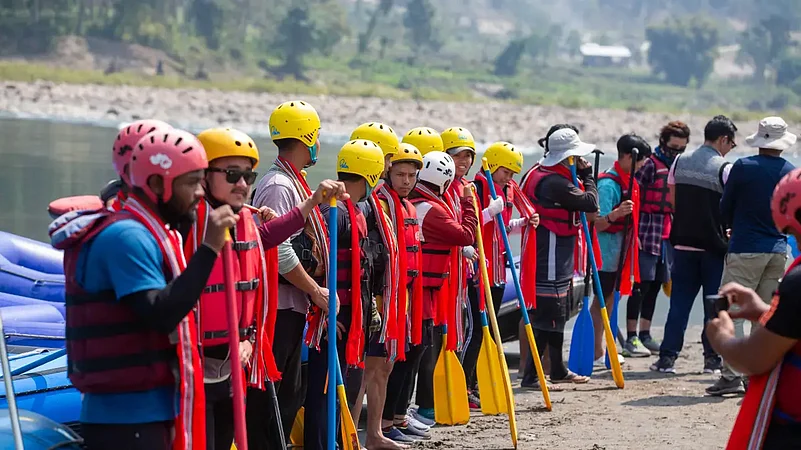This March when a handful of people had gathered on the banks of the Subansiri River in the small town of Daporijo in Arunachal Pradesh’s Upper Subansiri district, they had done so to witness who would win the first Subansiri River Rafting Competition. Amidst the predictable lineup of all-male competing teams, there was also a team of four young women.
For years now, when it came to river rafting in India, the most favoured destinations have been the glacial waters of the Western Himalayas along Haridwar and Rishikesh in Uttarakhand. However, for the serious rafting enthusiasts, the rivers of Arunachal Pradesh have always been the El Dorado- an almost mythical destination about whose rivers they have heard a lot but never experienced.
Arunachal Pradesh is home to five major river basins, starting from the west of the state with the Kameng, followed by the Subansiri, Siang, Lohit, and Tirap. These five basins were also the administrative divisions under which the state was divided in the early years of its formation.
Both casual and enthusiast rafters alike have steadily been flocking to the Siang basin for over two decades to experience its rapids which can reach grade IV. On the Kameng the rapid levels reach up to grade V but footfall has been slow. Along with adventure enthusiasts from and outside the state, the state tourism department has been looking to promote the rivers of the state as a rafting paradise through various national-level competitions over the years.
A major culmination of the years of efforts led to the state hosting the 15th National Rafting Championship held at Yinkiong in Upper Siang district in March this year on the Siang river. That competition comprised of four categories of Down River Race, Slalom, Sprint, and RX. The Indian Army teams took three podium positions in all four events. With dedicated teams, the Indian Army is often considered the benchmark for other rafting teams to follow in the country. So, it was hardly surprising that they secured top positions in that competition.
What did take some by surprise was the fact that a group of four women from Arunachal Pradesh came second in the women’s category.
That team comprised of Aruni Taniang, Devi Dada, Minam Teksing, and Omiti Teksing; the same four women who were also at Daporijo to participate in the Subansiri competition.
Speaking after the competition, Taniang said it was the first time that they had competed against men and were happy with the outcome even though they did not manage a podium finish.
“People probably thought our raft would flip but we managed to stay on. We are happy about that,” she said. Taniang is the default captain of the team and while she and her teammates may have been happy with their performance, it hasn’t been smooth sailing.
Most of her teammates took up the sport in 2012 when they were still teenagers at a workshop near Seppa in East Kameng district on the Kameng river. Almost a decade later, their resilience is starting to show results. However, they still have to deal with major hurdles.

With the cost of competition-level rafts running into lakhs of rupees, the women have been unable to purchase one for themselves. Taniang informed that they use the opportunity of rafting expeditions to get their practice and have to rely on organisers to practice just days before a competition begins.
Since the sport is still viewed as being fairly niche, information about rafting competitions is not as rapidly spread as football or other sports are. Despite these challenges, they appear to be doing fairly well for themselves.
--
Nino Dai, a foremost tour operator from the state and a pioneer in the field of river rafting, said that the Subansiri is his favourite river.
“I’ve been rafting on the Subansiri for 15 years and this is the first time that the state government has helped organise such a competition on this river,” he said.
Dai, who also doubles up as the president of the Arunachal Pradesh Watersports Association (APWA), said that only five teams could participate owing to paucity of time but that the scope of expanding the scale of the competition is very good.
“We hope to have around 20 teams next time,” he said.
He also said that in the future when the competition expands, they hope to add more events.
“One of the advantages of holding such adventure sports competitions in Arunachal Pradesh is that our people are very enthusiastic when it comes to attending them which is not always the case in other states,” he added.
Indian Rafting Foundation (IRF) president Shaukat Sikand who was also at Daporijo as a partner of the competition said that he was happy having organised back-to-back events in the state in two weeks.
“Daporijo is a remote place but we’re happy to have seen the participation,” he said, reserving special respect for the women’s team.
Sikand also said that the river is ideal for rafting and that with the build-up of infrastructure, the Subansiri can become the capital of river rafting in the Northeast.
After the event, he said that he hopes for teams from the state to represent India at international competitions.
Nobang Tayeng of the Arunachal Team that won the competition said that the team’s coordination helped them secure victory.

The competition winners covered the approximately 14 km stretch of the river from Sippi to Daporijo in 54 minutes.
The state tourism department’s director Abu Tayeng said that the competition was organised to promote the state as a go-to river rafting destination.
“In Arunachal Pradesh, we have rivers that offer different grades of rapids. This is just a beginning,” he said.
Tayeng, a known adventure enthusiast himself, has taken a keen interest in rafting and competitive angling in the state. In his role as the director of the tourism department, he said that the idea is not just to encourage rafting enthusiasts.
“We invited subject matter specialists to help us build a roadmap to take adventure activities ahead,” he said, adding that the idea is also to nurture local talent.
He said that such competitions will help train river guides in the state and that the women’s team securing the second position in the 15th National Rafting Championship was an encouraging sign.
--
Over the years, Arunachal Pradesh’s reputation as a rafting destination has been slowly growing. The flagship Siang Rush event has helped bring enthusiasts and novices alike to the state apart from bringing eyeballs.
Like most of the other major rivers in the state, the Siang also originates from the glacial waters of the Himalayas in the Tibetan Plateau, crashing along the ‘Great Bend’ before descending into the calm waters of the Brahmaputra in Assam.
Similarly, the Subansiri, too, originates in the high mountains of Tibet before descending into Indian territory.

While other rafting destinations such as the ones in Uttarakhand have always drawn visitors, in Arunachal Pradesh the scenario has been rather different owing to the lack of media coverage and inaccessibility (although that is changing recently).
Sikand, who has decades of experience in the field, said that the state’s river rafting potential is yet to be fully realised.
He said that the fact that there are relatively still very few dams that have been built in the state means that there is still huge potential for the exploration of the rivers.
--
















